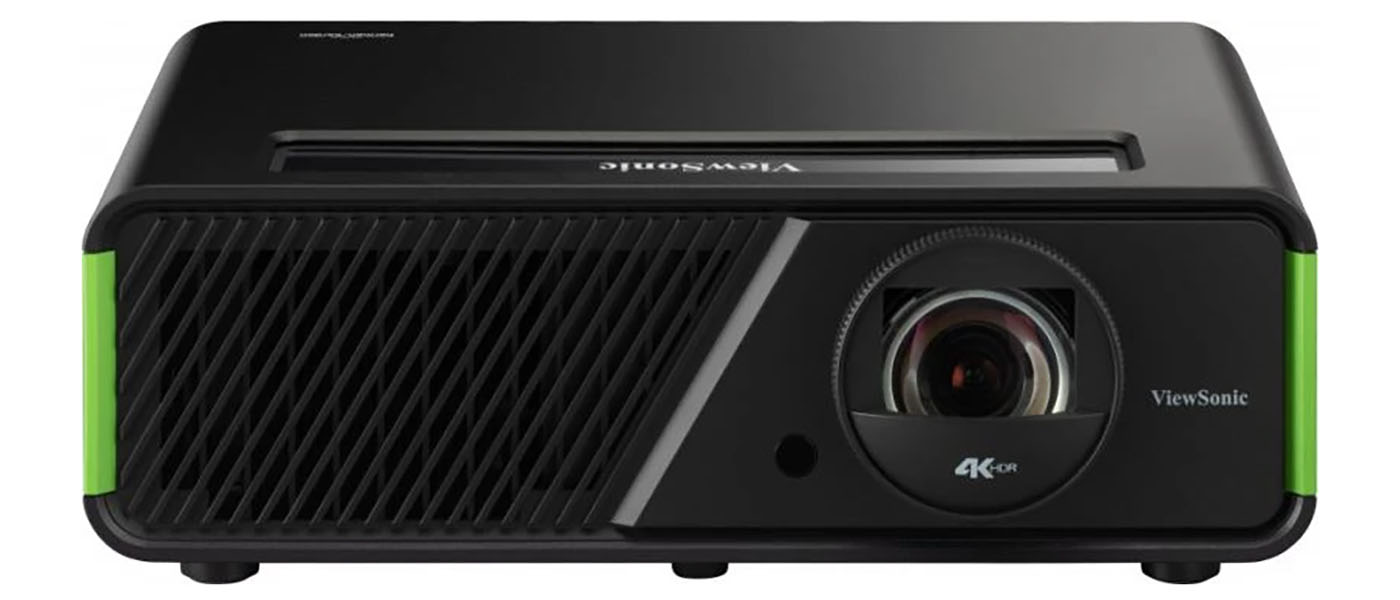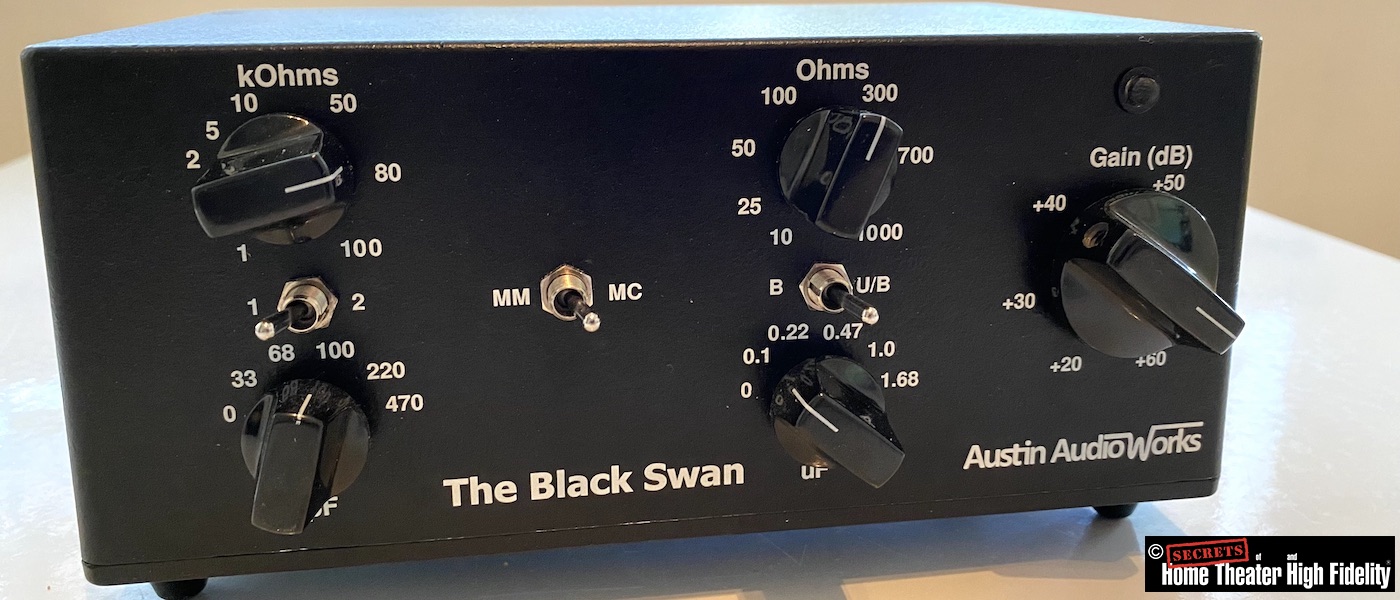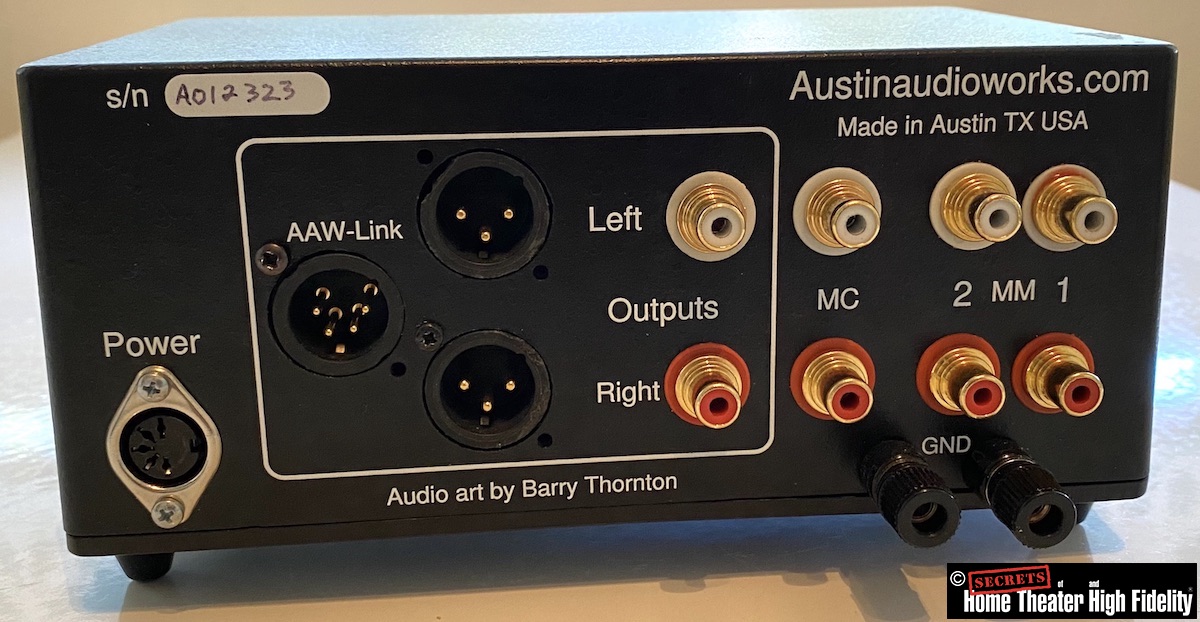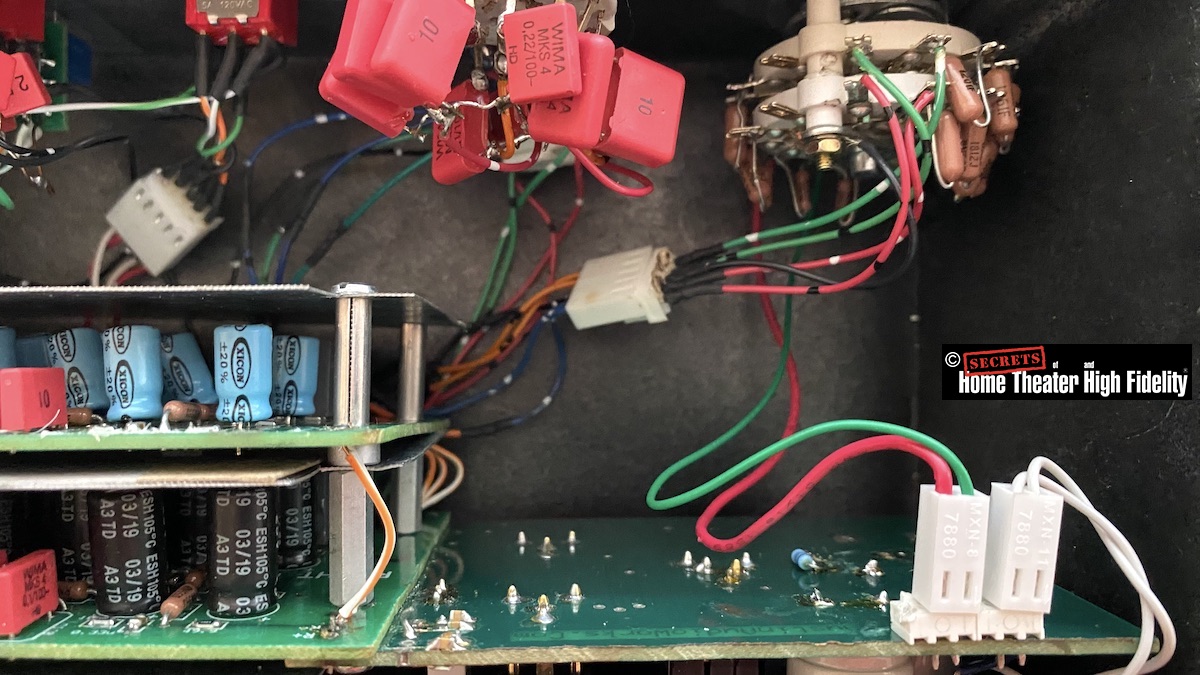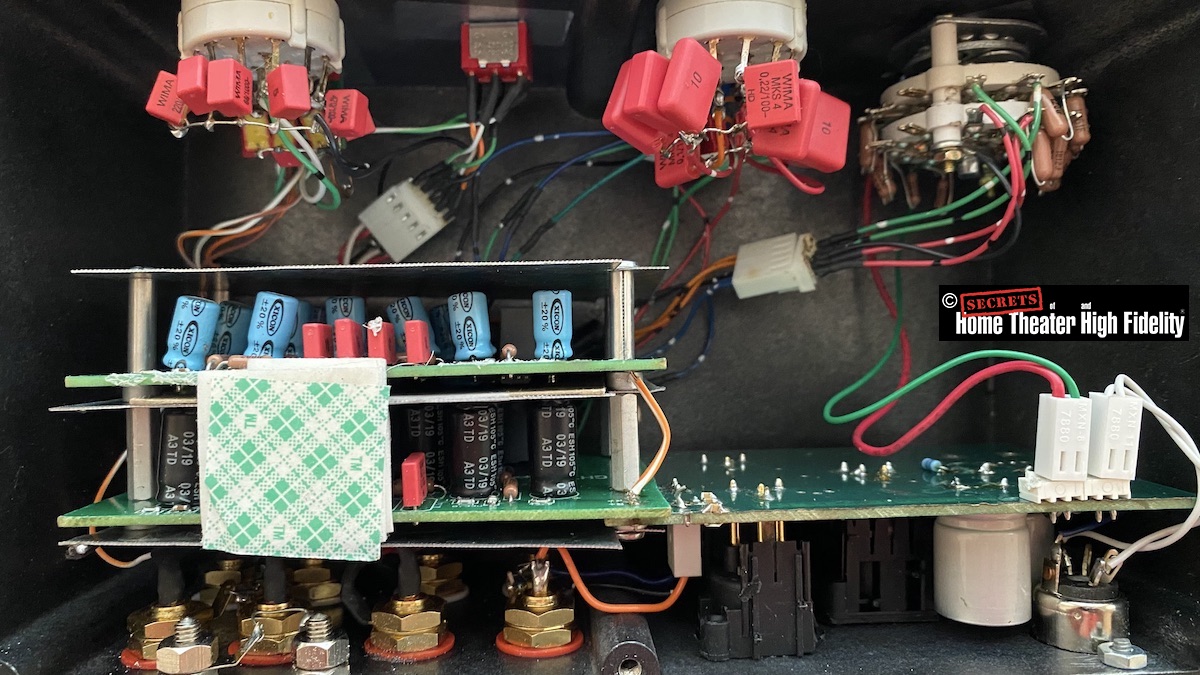Through his company, Austin Audio Works, he is designing and building, with his own two hands, components that essentially perform the role of the mythically perfect component: straight wire with gain. To that end, he is designing and building circuits that remove the noise that muddies the purity of the musical signal. His Black Swan phono preamplifier is one example of his design philosophy. So how does it sound?
Austin Audio Works Black Swan Phono Preamplifier Highlights
- You can adjust cartridge resistance and capacitance loading on the fly with knobs on the face of the unit.
- Three cartridge inputs: two for MM and one for MC.
- Both unbalanced RCA and balanced XLR outputs.
- Adjustable gain, so you can use it as a preamplifier.
- Can be used with a balanced tonearm (more on that below).
- Can be used to drive a pair of headphones with an appropriate 4-pin XLR cable.
- Designed and built in the USA.
Upon first glance, the Black Swan phono preamplifier from Austin Audio Works really isn’t that much to look at. It’s a plain black box with white lettering.
But don’t let the looks fool you. This thing is packed with features you simply won’t find in another phono preamplifier in this price range. The Black Swan has not one, not two, but THREE phono inputs. It has a gain knob so you can attach it directly to an amplifier and use it as a preamplifier. That enables you to send a much purer analog signal to your amplifier and speakers. And you can adjust cartridge resistance and capacity loading on the fly with the knobs on the face. No jumpers to move around with tweezers and no toggle switches to flip with a toothpick. Just good, old-fashioned knobs you twirl around until your cartridge sounds as good as you can get it. And, as if that weren’t enough, you get both RCA and XLR outputs.
The Black Swan is the brainchild of Barry Thorton, the man behind Austin Audio Works. He is trained both as an anthropologist and as a physicist. As a physicist, he understands the fundamentals of how electrons flow from one point to another. But as an anthropologist, he thinks deeply not only about HOW we humans listen to music but also WHY we listen to music. By combining these two disciplines into his audio design paradigm, Thornton is designing and building components that do a remarkable job of passing electrons from one point to another without imposing any character on the electrons whatsoever. The Austin Audio Works Black Swan sells for $1450 and is sold directly to consumers through the company’s website.
INPUTS:
Two pair RCA
One pair balanced XLR
OUTPUTS:
One pair RCA
One pair balanced XLR
“AAW Link” 4-pin XLR
OUTPUT VOLTAGE:
RCA, left or right channel into a 10kOhm load, 9vRMS
XLR balanced into a 10kOhm load, 18vRMS
TOTAL HARMONIC DISTORTION:
MM at 1vRMS out Ref 5mV in at 1kHz, 0.003% THD + noise
MC at 1vRMS out Ref 1mV in at 1kHz, 0.003% THD + noise
NOISE:
MM at 47kOhm and 0pF setting, gain at 45dB, input reference 5mV, output 1vRMS into 10kOhm load, -70dB unweighted, -80 “A” weighted.
MC at 100Ohm and 0pF setting, gain at 65dB, input reference 0.5mV, output 1vRMS into 10kOhm load, -58dB unweighted, -68dB “A” weighted.
INPUT OVERLOAD:
MC 100mV
MM 6mv
RIAA EQUALIZATION:
+/- 0.1db
POWER SUPPLY:
16vRMS
POWER CONSUMPTION:
1.7w
WEIGHT:
3 lbs. (1.3kg)
DIMENSIONS:
7.9” (201mm) wide x 4.77” (122mm) deep x 3.6” (90mm) high
COLOR:
Black
MSRP:
$1,645.00 USD
Website:
SECRETS Tags:
Austin Audio Works, Black Swan, MM, MC, cartridge, phono, preamplifier, mono, stereo, reviews 2023
The Black Swan is a solid-state phono preamplifier designed and built by hand by Barry Thorton in Austin, Texas. The design of the Black Swan started from the idea that the resolving capability of a phono preamplifier is influenced by noise. It is essentially two independent amplifiers with passive equalization that share a common power supply in a common chassis. While the inputs are labeled “Left” and “Right,” there is no internal commitment to either a left or right channel. It’s the job of the cartridge to distinguish between left and right, and the Black Swan just gets out of the way and lets the cartridge’s signals travel through.
Secrets Sponsor
Its power supply is 16VRMS, utilizes low-voltage AC, and is isolated from the grounds and mains power system by its transformer. This transformer is also a big inductive filter to reject line noise. The unit’s internal power system takes the balanced AC and produces buffered, isolated, and regulated DC voltages to power the unit’s amplifiers.
On its face to the left are two knobs for setting loading and capacitance for MM carts, then a toggle switch to choose between MM inputs 1 or 2. There is another toggle switch to the right to choose between the MM or MC input. Then there are two knobs for setting loading and capacitance for MC carts. To the farthest right is the gain adjustment knob.
On the rear of the unit to the left are three XLR outputs, the “AAW Link,” and left and right XLR, then there are the two RCA outputs. To the right of those are the three pairs of RCA inputs for the two MM and one MC tonearms. Then there is a ground terminal and the input for the power supply. While not on my review sample, I’ve been informed that a rotary switch will be added to the back side that will adjust the intensity of the front panel blue power LED, going forward.
What’s this about balanced tonearm output?
According to Thornton, it is highly probable that your turntable feed is wired in balanced mode already even though it is terminated with RCA connectors. To that end, he designed the Austin Audio Works Black Swan to be used in a balanced mode. The Black Swan uses a differential amplifier as a first stage, which means the signal path will remain balanced throughout the amplifier. To test that, you can flip a toggle switch on the face of the unit to determine if the sound of the tonearm improves or not. Very simple. Please note that the tonearm must be grounded to run it in balanced mode.
Designed for the lowest noise floor.
According to Thornton, the input gain stage is the most important system in a phono preamplifier. In the Black Swan, he employs a compound parallel input technique that combines four precision low-noise gain cells. The cells are configured such that the stages cancel each other’s internally generated silicon-based noise and thus achieve an unprecedentedly low operational noise character.
Secrets Sponsor
The Black Swan has both unbalanced RCA and balanced three-pin XLR outputs. There is also an “Austin Audio Works Link,” which is an alternate, balanced 4-pin XLR output. This enables you to connect the Black Swan to another Austin Audio Works amplifier with a single 4-pin XLR cable. Neat.
The Austin Audio Works Link can also be used to drive a pair of headphones if they are wired with an appropriate four-pin XLR connector. The unit’s manual provides a wiring diagram for this.
RIAA Equalization
The RIAA equalization in the Black Swan is purely passive. Employing active equalization can produce time-based dynamic distortions such as slewing inter-modulation distortion and transient inter-modulation distortion. Anytime feedback is used to try to “perfect” a filter network’s amplitude or phase performance, you lose some of the dynamic performance of the filter. The choice and use of better components and a bit more design effort can provide dramatic sonic improvements that offset any of the cost savings obtained.
The installation was relatively straightforward. Attach your tonearm output cable(s) into the appropriate MC or MM input then attach the power supply, and you’re good to go. A blue LED will let you know the thing is powered on, and there is no on/off switch. I keep it powered on 24/7 and use some electrical tape to cover the LED light because it is very bright.
I tested the Black Swan with my restored Thorens TD-124 turntable and a Jelco SA-250 9-inch tonearm. That tonearm has a removable headshell so I used three different cartridges with it.
The first cart I listened to is a Zu Audio Denon DL-103R in the original silver body ($700US). Its output voltage is .25mV. I had this cart rebuilt by Joseph Long, aka “groovetickler” on Instagram. I had badly bent the cantilever many years ago, and Long replaced it with a new hardened aluminum-magnesium cantilever and reused the original stylus diamond. It was excellent work at an excellent price, and he resurrected a cart I had written off as useless.
The second cart is a Grado Platinum Statement high-output moving coil cart ($400US). Its output voltage is 4.0 mV.
And the third cart is a cheap and cheerful Audio Technica VM610 mono MM cart ($140US). Its output voltage is 3.0mV. This cart has a 0.6mil conical stylus on an aluminum cantilever.
For the testing of the Austin Audio Works Black Swan, my system comprised an Orchard Audio Starkrimson Stereo Ultra amplifier driving a pair of Polk Audio Legend L600 speakers. Preamp used was the Schiit Audio Freya+. I ran the Freya+ in its passive mode during the cartridge comparisons to remove as much coloration as possible from the sound.
Over the years I have found that the suggested loading and capacitance settings suggested for a cartridge are just that, suggestions. Those numbers give you a target to get close to but aren’t always exactly correct. And those settings may be good for one album but not the best for another album. That is why I like using phono preamplifiers that enable me to easily adjust loading and capacitance settings with adjustment knobs.
I got in the habit of writing down the configuration of the Black Swan that worked for particular albums and cartridges in a notebook I keep near my system. That way I could quickly adjust the Black Swan to what I wanted for each by just turning a couple of knobs quickly. Note that I did not have to open the component to get to jumper cables or find a toothpick to move around any dipswitches. My lifestyle choice is to not use phono preamplifiers that do not enable me to easily change settings on the fly.
A note about gain matching
Because it has a gain adjustment, you can theoretically use the Austin Audio Works Black Swan as a pure preamplifier. However, there is no guarantee it will integrate well with all amplifiers. When I ran the Austin Audio Works Black Swan straight into my Orchard Audio Starkrimson Stereo Ultra amplifier, which outputs quite a lot of power, the output gain was far too high for me to listen to my satisfaction. Using a Schiit SYS passive preamp enabled the Black Swan to behave with the Starkrimson amp, but that defeated the purpose, and I ended up abandoning that exercise. However, the Black Swan integrated very well with my Mcintosh MC30 tube amps, which output 30 watts per channel. That combination gave me the best analog sound I have ever heard in my system. The tubey midrange magic of that combination was detailed and very fast.

Slack “Bigger Than Breakfast”
Slack, Bigger Than Breakfast (Blue Yonder Sounds 0113, 1987), played with the Zu Denon DL-103R stereo cart. Slack were a six-piece outfit that delivered the maximum funk on this album. I’ve been listening to this album since 1987, but the Black Swan showed me aspects of the music I never even suspected were there. I first noticed how pinpoint accurate the soundstaging was. I could see each musician distinctly on the soundstage, and also hear each musician’s instrument on the soundstage. I was hearing so much more spatial information that the record seemed bigger and even more energetic. Being able to visualize the entire group playing together added an organic coherence to the music I didn’t know was possible with my system. For me, more sonic detail means I hear more human, more energy, and more of the fun.
For this cart and this album, the Austin Audio Works Black Swan settings I used were 800 Ohms and 0.47 uF.

Doris Day “Show Time”
Doris Day, Show Time (Columbia Cl 1470 mono, 1960), played with the Grado stereo cart.
I’m a big believer in the magic of mono records and generally prefer them to the “rechanneled for stereo” versions of albums. But, as a test, I played this album with my Grado stereo cart, and boy, what a surprise that was. The imaging and stereo separation were far better than I expected. I could easily place instruments and voices in the soundstage, even with the stereo cart. As another test, I listened to this with my two Mcintosh MC30 tube amps instead of the two-channel Orchard Audio Starkrimson. To give it a true mono test, I turned down the gain on one of the amps and positioned one of the speakers in the middle of my room. It looked weird but it sounded amazing. Even when played with a stereo cart through the Black Swan phono preamp with only one speaker, the soundstaging on a mono album was still as good as it was with using two amps and two speakers. The channel separation was so good that with one channel powered down completely, I still got the full mono experience. It made me seriously reconsider my belief that I need a dedicated mono cartridge for mono albums.
For this cart and this album, the Austin Audio Works Black Swan settings I used were 400 Ohms and 0.1 uF.

Frank Sinatra “Songs For Swingin’ Lovers!”
Frank Sinatra, Songs For Swingin’ Lovers! (Capitol Records/Universal Music Group International 602547628626 mono, 2016), played with Audio-Technica VM610 mono cart. I’ve had this mono cart for a few years and have listened to it with several other phono preamplifiers, but never has it sounded this good. The low noise floor and speed of the Black Swan really enabled this inexpensive cart to shine. I heard an impressive increase in energy and spatial clues; it was as if the cart had woken up and was happy to be alive. And that really contributed to the excitement of listening to this album. It was as though I was finally hearing what this cart was capable of when the phono preamplifier got out of its way.
I use this album as a reference recording and currently have nine separate vinyl pressings of it, and this 2016 mono remaster is the best sounding I’ve heard so far. When played through the Austin Audio Works Black Swan, this $140 Audio-Technica cart made the system disappear with a huge soundstage and spatial separation I’d expect from a cart several times its price. It got my face grinning, my fingers snapping, and my toes tapping, and who doesn’t want to get that when they’re listening to music?
For this cart and this album, the Austin Audio Works Black Swan settings I used were 80 kOhms and 470 pF.
The Austin Audio Works Black Swan gave me the best analog playback I have ever had in my system. It presented me with an amazing fidelity of timbre and transparency, and an all-encompassing soundstaging. I realized I could not live without it and bought the review sample. This thing made literally every single album I listened to sound better. And I mean every one. Amazing.
- Exceptionally transparent sound.
- Exceptional channel separation.
- High number of inputs for its price range.
- Can be used as a preamplifier.
- Very easy to configure to optimize the output of phono cartridges.
- A way to dim or disable the blue LED on the face. (Which will be addressed in further production.)


